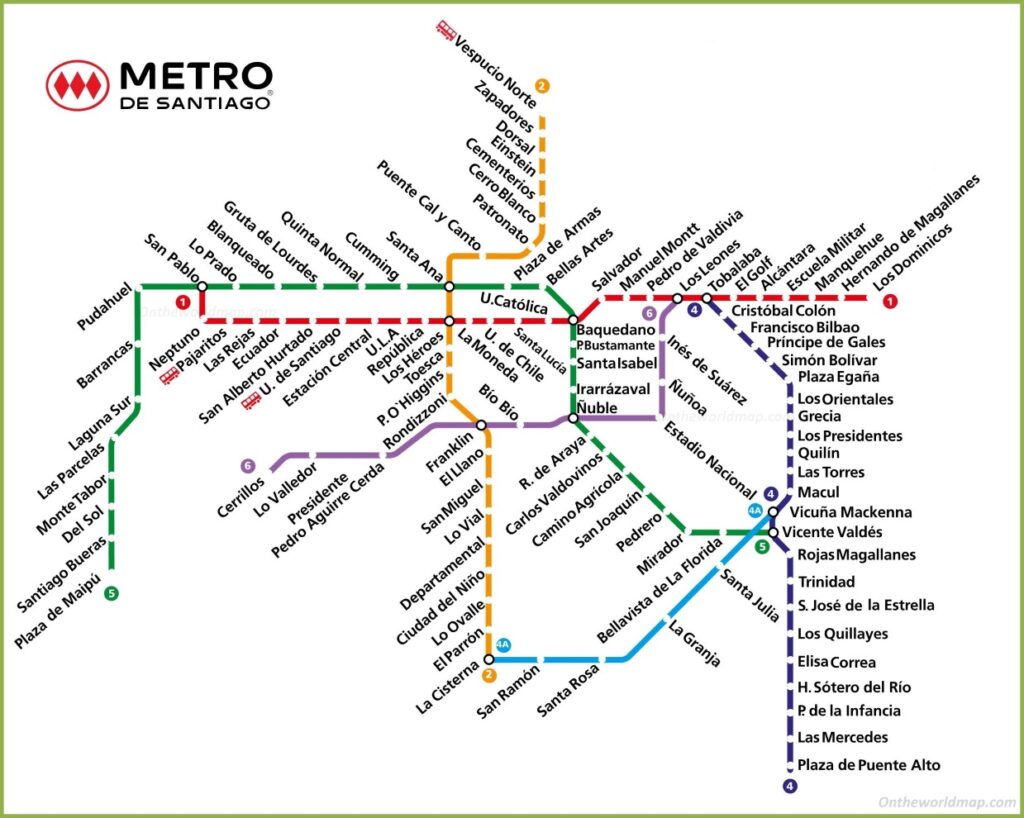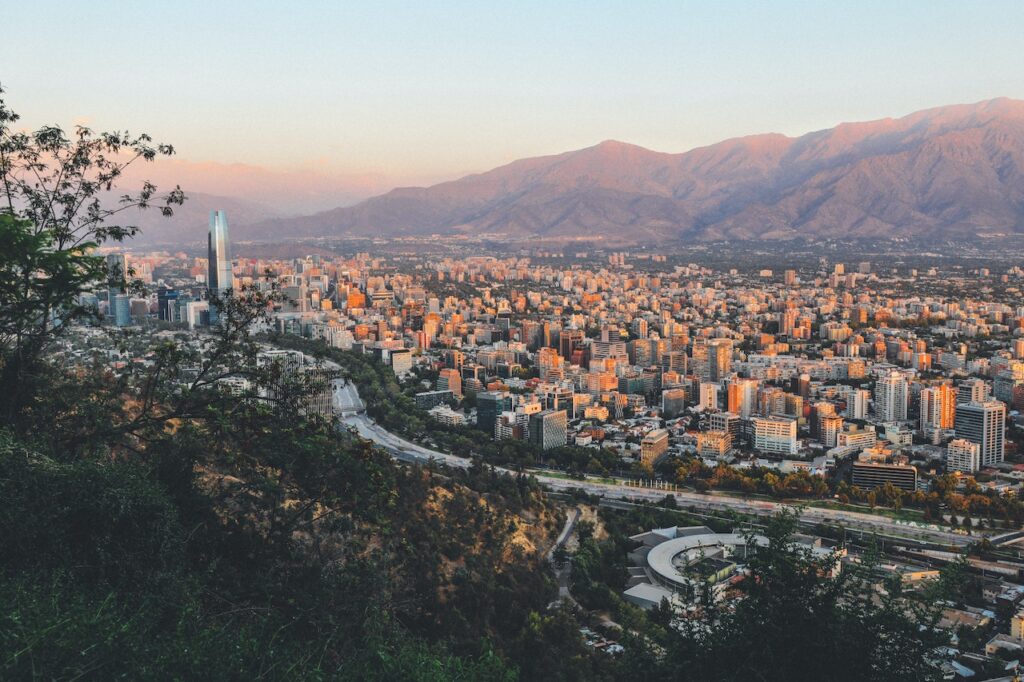Santiago’s public transit system is a fantastic way to get around the city. The metro, which is a huge network of underground rails that goes around most of the city, is the most popular way to get around. In addition, you can go around the city via buses, trolleybuses, and trams. Taxis are another option that is practical for getting around and avoiding traffic. The city also offers shared bike programs and bike lanes, which are fantastic ways to explore the area while getting some exercise.
Basic information about the Metro system in Santiago de chile
The primary means of public transit in Santiago, Chile is the Santiago Metro, which is also the largest metro system in South America. It was first built in 1975 and now has 6 lines and 104 stops, carrying more than 2.7 million people every day. The system connects several neighborhoods in a way that makes it easy and quick to get around the city. Metro stations have interactive maps, ticket machines, and automatic gates, and the lines are designated by numbers and colors. The Santiago Metro is one of the best and cheapest ways to get around on public transportation in the world.
The lines of the Santiago de Chile subway system
The Santiago subway system is a crucial component of Santiago’s bustling and energetic urban life. The foundation of the city’s public transportation system is the city’s four metro lines: Lines 1, 2, 4, and 5.
Santiago’s Line 1 subway travels north-south through the heart of the city between San Pablo and La Cisterna. Due to its connection to some of the most well-known locations in the city, this line is particularly crowded during rush hour. Additionally, it travels by Central Station, which serves as the primary intercity transportation center.
Between Los Dominicos and Las Rejas, the Santiago metro Line 2 travels in an east-west route. Due to its proximity to some of the city’s most well-known landmarks, like the Plaza de Armas and the Palacio de la Moneda, this line is well-liked by tourists.
Between Vicua Mackenna and Los Leones, the Line 4 of Santiago’s metro travels in a north-south direction. Due to its proximity to some of the city’s most significant academic institutions and commercial areas, this line is primarily used by commuters and students.
Between Quinta Normal and La Granja, the Santiago subway’s Line 5 travels in an east-west direction. This railway primarily serves as a conduit between the city’s outer suburbs and its downtown.
The Central Station in Santiago is connected to all four of the Santiago subway lines, making it simple and quick for travellers to switch lines. One of the best public transit networks in the world, Santiago’s subway system is crucial to the smooth operation of the city.
Map of santiago Metro 2023 – Free Download in PDF

Click and download the map of Santiago de Chile underground system for 2023
For the people of Santiago, Chile, the metro system is a crucial means of mobility. The Santiago Metro Map 2023 is a free PDF download that shows all of the current and planned metro lines, as well as how they connect to buses and trains. The new Line 6 and Line 7, which are expected to be finished in 2023, are included on the map together with all other existing and upcoming metro lines. To assist travelers in planning their routes, the map also includes information such as stops, transfer spots, station locations, and street names. With the help of the Santiago Metro Map 2023, locals and visitors to Santiago can travel more quickly and efficiently to their destinations.
Public transport tickets in Santiago – Best types for travelers & actual prices
Santiago’s public transportation tickets can be a complicated subject for both tourists and locals. To fully utilize the city’s public transportation system, it is critical to have a solid awareness of the various ticket options and their associated costs.
A Bip! card must be purchased as a first step. This contactless card can be used on several ferries, the Metro, and buses in Santiago. The card can be purchased for 2,000 Chilean pesos (about $3 USD) at any Metro station. After that, you have to put money on the card, which you can do at Metro stations. You can choose how much to recharge based on how often you want to use public transportation. Once you have your Bip! card, you must choose the ticket type that is most appropriate for you. The single-trip ticket, which costs 800 Chilean Pesos, is the most affordable one. This ticket is not refundable and cannot be transferred, and it is only good for one trip on the Metro or a bus.
If you plan to take public transportation often, it might be worth it to buy a ticket that lets you go more than once. This 3,500 Chilean Peso ticket is good for 10 trips on the bus or the metro. Unused trips do not expire, and the ticket is good for 30 days after the date of purchase. As an alternative, you might wish to think about the “Unlimited Pass” if you intend to stay in Santiago for a longer period of time. This ticket costs 4,500 Chilean pesos and is good for unlimited bus and metro travel for one calendar month.
It’s also crucial to remember that ticket costs differ based on the mode of transportation you choose. A single-trip ticket for the Metro, for instance, costs $800 Chilean Pesos, while a single-trip ticket for the bus, for example, costs $650 Chilean Pesos.
If you want to get the most out of Santiago’s public transportation, you should know about the different types of tickets and how much they cost. It is feasible to select the most cost-effective ticket for your needs with a little effort and study.
The most popular ticket type is the Billete nico, a prepaid card that can be loaded with credit and used on all forms of public transit. This card would be adored by frequent users because it provides discounts and other benefits. Depending on the distance traveled, prices range from 800 Chilean pesos (about $1 USD) for a single journey to 3,600 Chilean pesos (around $5 USD) for a full-day pass. A cheap 10-trip ticket is additionally offered.
The “Tarjeta Bip!” is a less expensive option. It costs 1500 Chilean pesos (about $2 USD) to buy and load with money. This card can be used on all types of public transportation and gives some discounts. Depending on the distance traveled, the cost can range from 500 Chilean pesos (less than $1 USD) for a single journey to 2,100 Chilean pesos (approximately $3 USD) for a full-day permit.
Additionally, tourists can purchase specialized tickets. One of these is the “Tourist Pass,” which lets the holder use public transportation as much as they want for three days. It costs 5,000 Chilean pesos (around 7 USD). The “Weekend Pass,” which is good for two days and gets you discounts at several attractions, is another option. The cost is 3,500 Chilean pesos (around 5 USD).
No matter which kind of ticket you choose, all tickets need to be validated before using public transportation. This can be done at the ticket windows located at each station.
Summary of fares for public transport in Santiago de Chile
- In order to use public transit, a Bip! card must be obtained. – $3,000 (about $2000) in Chilean Pesos
- A one-way ticket to Chile costs 800 Chilean Pesos (not refundable or transferable)
- A round-trip ticket to Chile costs $3500. (valid for 30 days after purchase)
- The price of the Unlimited Pass is 4500 Chilean Pesos (valid for one month)
- Visitor’s Pass (3 days unlimited use) – 5,000 Chilean Pesos, or roughly $7 US
- Weekend Ticket (2 days) – 3,500 Chilean Pesos, which is about $5 US
Timetables & Schedules of Santiago de chile Metro system
On weekdays, the Santiago Metro system is open from 5:00 to 23:00, on weekends and holidays, it is open from 6:00 to 22:00. The metro runs in 3- to 5-minute intervals between 06:00 and 9:00 on weekdays and 17:00 and 20:00 on weekends during peak hours. On Saturdays, Sundays, and holidays, the metro runs every five to ten minutes. One of Latin America’s most effective and dependable metro systems, the Santiago Metro system can transport users quickly from one side of the city to the other.
What Are Other Options For Public Transportation In Santiago?
Having access to dependable and convenient public transit is essential when visiting Santiago, Chile. Although the metro system in the city is amazing, it is not the only means of public transportation available there. Here are a few other Santiago public transportation alternatives.
Bus: Santiago has a large and reliable bus network with more than 4,500 buses in its fleet. There are more than 800 routes, and most of them leave from busy areas like the Universidad de Chile, Plaza de Armas, Puente Cal y Canto, and Plaza Italia. Buses have air conditioning and are secure, hygienic, and cozy. A ticket will set you back between $0.90 and $1.50 USD.
Taxi: Taxis are widely available and a convenient way to navigate around Santiago. Taxis are offered both with and without metres. While non-metered taxis can be requested in advance or found at specific taxi stands, metered taxis can be hailed on the street. Even though most taxis are safe and have fair prices, you should always try to negotiate the price before getting in.
Cycling: While Santiago does not have as many bike-friendly areas as other cities, it does have some. A number of bike lanes and bike-sharing programs have been created by the city to make it simpler for cyclists to get about.
Walk: With many pedestrian-friendly districts, Santiago is a very walkable city. There are many stores, eateries, and activities close by in the city center, which is very walkable.
As you can see, Santiago offers a wide variety of public transportation alternatives. There is something for everyone, whether you want a cheap means to move around or a more opulent choice. Santiago’s transportation choices make moving about the city simpler than ever.
How To Get From Arturo Merino Benítez International Airport (scl) To The City Center With Public Transport?
Public transportation is the best option if you’re seeking an inexpensive and practical way to go from Arturo Merino Benitez International Airport to the city center. In this article, we’ll go through how to use public transportation to get from the airport to the city center.
Take the Metro from the airport as your first step. The airport’s internal Metro station is reachable from the arrivals area. A ticket can be purchased at the ticket office or at the station’s ticket machines. Take the train and get out at the Escuela Militar stop as soon as you get your ticket.
You’ll need to catch a bus into the city center from Escuela Militar. The TurBus, Pullman Bus, and Transvip are just a few of the bus companies that operate in the region. Tickets for the buses, which are outside the station, can be bought at the ticket office or at the ticket machines.
Public transportation is a simple and practical way to commute from Arturo Merino Bentez International Airport to the city centre. All you have to do is ride the Metro into the city centre from the airport. You’ll be able to travel easily if you have the necessary knowledge.
What kind of sightseeing do you have to do if you visit Santiago de Chile for the first time?
The world’s most stunning attractions may be found in Santiago, the capital of Chile. Santiago has enough to offer everyone, from breathtaking mountain ranges to fascinating museums. The top places to go in Santiago are listed below:
- San Cristóbal Hill: One of the best places to see Santiago is from this hill. Visitors may enjoy a spectacular perspective of the city on a clear day. In addition, the hill offers a variety of pathways for exploration, making it a fantastic place for hiking.
- Plaza de Armas: Santiago’s principal square, situated in the heart of the city. Numerous historical sites, such as the National History Museum and the Palacio de la Real Audiencia, may be found there, along with many other stunning buildings.
- Parque Forestal, a sizable park in the centre of Santiago. Biking, strolling, and jogging are just a few of the activities that visitors can engage in while exploring the rich environment.
- Mercado Central: This market is situated right in the middle of Santiago. It is one of the oldest marketplaces in the city and is populated by numerous sellers who sell seafood, fresh produce, and other things.
- Cerro Santa Lucia: Santiago is centred on this hill. It has a magnificent castle as well as other other attractions, such as a lovely vantage point of the city.
- Museo de la Memoria y los Derechos Humanos: This museum honours Chilean victims of oppression as well as human rights. It is a fantastic location to learn about the history of the nation and its citizens.
These are only a few of the best sights to see while in Santiago. Santiago offers lots to offer everyone, whether you’re seeking for outdoor recreation, historical attractions, or cultural encounters.
Summary of our tour guide for Santiago
Chile’s capital city, Santiago, is one of the most populous in all of Latin America. It is renowned for both its thriving culture and stunning scenery. With the Metro de Santiago as the main way to get around, Santiago’s public transportation is reliable and easy to use. Many of the city’s communities are connected by this train system, making transportation simple. For those who would rather explore the city on two wheels, Santiago also offers a bike rental program in addition to buses and taxis. Because the public transportation system works well, Santiago is a great city for tourists to visit and enjoy.
Top 5 FAQs and answers about Santiago public transport?
- Does Santiago have good public transportation?
- Santiago has a dense public transportation network. In order to use the network, you need to buy a “BIP” card first, at the counter in the subway. Then, you can charge the amount you want, from $100, in a subway station or in newsstands located in many parts of Santiago.
- What are three main ways you can stay safe using public transport?
- Safe travel
- Wash your hands before and after you travel. If you are unwell, stay home and get tested. Keep your distance where you can.
- What is the best way to travel around Santiago Chile?
- The best ways to get around Santiago are on foot and by metro. Since the city’s streets are laid out on a grid, exploring on foot is an easy way to take in the sights. The metro also serves as an efficient, inexpensive and reliable way to travel between barrios, plus its lines service the city’s top attractions.
- What are the 5 major methods of transportation?
- Top 5 Modes of Transportation in Logistics
- Road Transportation. There are many advantages to road transportation, especially for companies who rely on fast delivery to retain their customers. …
- Rail Transportation. …
- Marine Transportation. …
- Air Transportation. …
- Intermodal Transportation.
- What are the 5 benefits of transportation?
- Here’s a look at eight transportation benefits to consider:
- Improves Community Health. …
- Economic Benefits to the Community. …
- Improves Fuel Efficiency. …
- Public Transportation Reduces Air Pollution. …
- Improves Road Congestion. …
- Improves Community Mobility. …
- Provides an Equitable Transportation System.
Useful links
- Official website of public Santiago transport company







